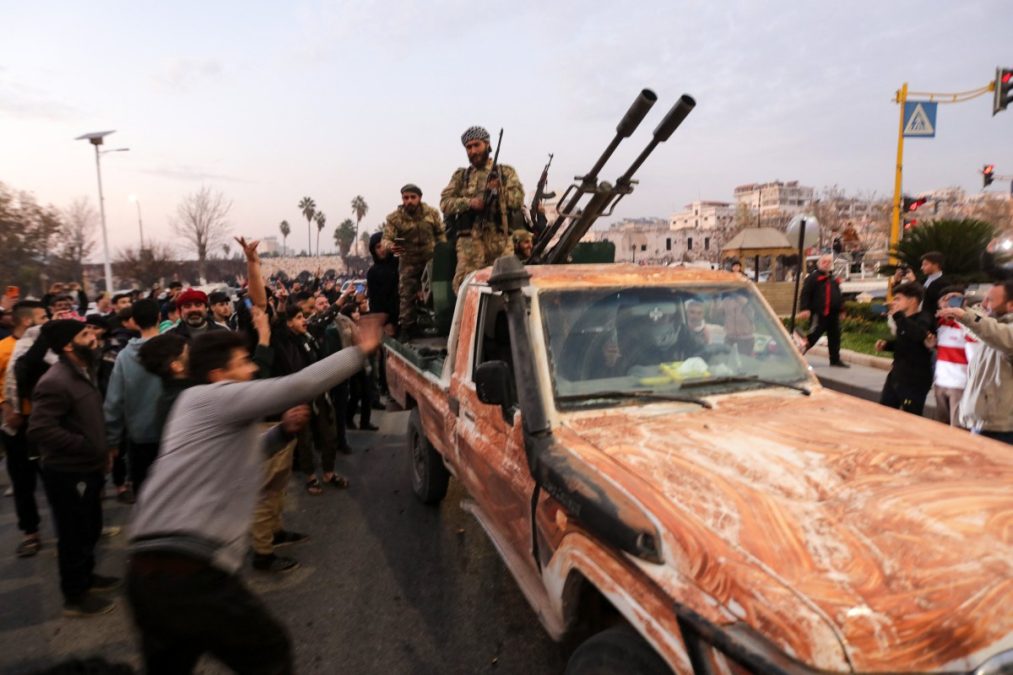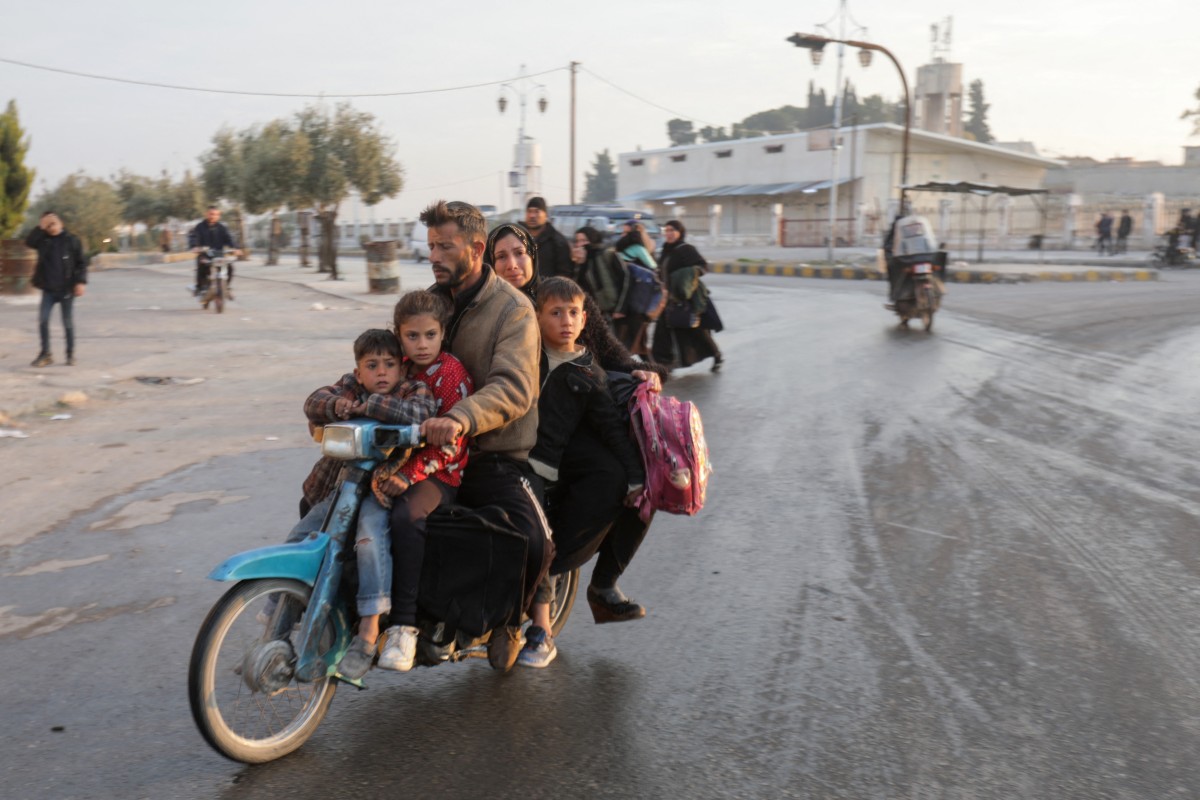Beirut, Lebanon – Tens of thousands of members of President Bashar al-Assad’s Alawite minority community were fleeing Syria’s third city Homs Thursday, for fear that Islamist-led rebels would keep up their advance, a war monitor said.
Homs lies just 40 kilometres (25 miles) south of Hama, which the rebels captured on Thursday.
Analysts said they expected the fighters led by Islamist group Hayat Tahrir al-Sham (HTS) to push on towards the city, a key link between Damascus and the Alawite heartland on the Mediterranean coast.
Britain-based war monitor, the Syrian Observatory for Human Rights, reported “the mass exodus of Alawites from Homs neighbourhoods, with tens of thousands heading towards the Syrian coast, fearing the rebel advance”.
Khaled, who lives on the city’s outskirts told AFP that “the road leading to (coastal) Tartus province was glowing… due to the lights of hundreds of cars on their way out”.

In April 2014, at least 100 people, mostly civilians, were killed in twin attacks in Homs that targeted a majority Alawite neighbourhood.
The attacks were claimed by the Al-Nusra Front, the Syrian branch of Al-Qaeda which now HTS leader Abu Mohammed al-Jolani previously led.
Jolani announced his group had cut ties with the jihadists in 2016, and Al-Nusra was dissolved the following year, to be replaced by the key component of HTS.
Haidar, 37, who lives in an Alawite-majority neighbourhood, told AFP by telephone that “fear is the umbrella that covers Homs now”.
“I’ve never seen this scene in my life. We are extremely afraid, we don’t know what is happening from one hour to the next,” he said.
He has managed to send his parents to Tartus, but has not found a car to take him and his wife “due to the high demand”.
“When we find a car, we’ll leave as fast as possible for Tartus.”
The province, which hosts a naval base operated by Assad ally Russia, has remained safe though 13 years of war.
Earlier, Islamist-led rebels captured the central Syrian city of Hama on Thursday in a new blow to President Bashar al-Assad’s forces days after they lost the country’s commercial hub Aleppo.
The rebels led by Islamist group Hayat Tahrir al-Sham (HTS) launched their offensive little more than a week ago, just as a ceasefire in neighbouring Lebanon took hold between Israel and Assad’s ally Hezbollah.
Following overnight clashes, the rebels stormed Hama “from several sides” and engaged in street battles with Assad’s forces, Britain-based war monitor, the Syrian Observatory for Human Rights, said.
The rebels later announced “the complete liberation of the city of Hama”, in a message on their Telegram channel.
Rebel fighters kissed the ground and let off volleys of celebratory gunfire as they entered Syria’s fourth largest city.
Many residents turned out to welcome the rebel fighters. An AFP photographer saw some residents set fire to a giant poster of Assad on the facade of city hall.
The army admitted losing control of the city, strategically located between Aleppo and Assad’s seat of power in Damascus.
Defence Minister Ali Abbas insisted that the army’s withdrawal was a “temporary tactical measure”.
“Our forces are still in the vicinity,” he said in a statement carried by the official SANA news agency.
‘Massive blow’
Aron Lund, a fellow of the Century International think tank, called the loss of Hama “a massive, massive blow to the Syrian government” because the army should have had an advantage there to reverse rebel gains “and they couldn’t do it”.
He said HTS would now try to push on towards Syria’s third largest city, Homs, some 40 kilometres (25 miles) to the south, where many residents were already leaving on Thursday, images on social media showed.
Observatory director Rami Abdel Rahman reported a mass exodus from the city of members of Assad’s Alawite minority community.
He said tens of thousands were heading towards areas along Syria’s Mediterranean coast, where the Alawites, followers of an offshoot of Shiite Islam, form the majority.
“We are afraid and worried that what happened in Hama will be repeated in Homs,” said a civil servant, who gave his name only as Abbas.
“We fear they (the rebels) will take revenge on us,” the 33-year-old said.
Until last week, the war in Syria had been mostly dormant for years, but analysts have said it was bound to resume as it was never truly resolved.
UN chief Antonio Guterres said the flare-up reflects “the bitter fruits of a chronic collective failure of previous de-escalation arrangements”.
In a video posted online, HTS leader Abu Mohammed al-Jolani said his fighters had entered Hama to “cleanse the wound that has endured in Syria for 40 years”, referring to a crackdown on the Muslim Brotherhood in 1982, which led to thousands of deaths.
“I ask God almighty that it be a conquest with no revenge,” he added.
In a later message on Telegram congratulating “the people of Hama on their victory,” he used his real name, Ahmed al-Sharaa, instead of his nom de guerre for the first time.
Fierce fighting
The Observatory said 826 people, mostly combatants but also including 111 civilians, have been killed in Syria since the violence erupted last week.
It marks the most intense fighting since 2020 in the civil war sparked by the repression of pro-democracy protests in 2011.
Key to the rebels’ successes since the start of the offensive last week was the takeover of Aleppo, which in more than a decade of war had never entirely fallen out of government hands.
While the advancing rebels met little resistance earlier in their offensive, the fighting around Hama has been especially fierce.
The Observatory reported 222 people killed in Hama province since Tuesday evening, four of them civilians.
Assad ordered a 50-percent raise in career soldiers’ pay, state news agency SANA reported Wednesday, as he seeks to bolster his forces for a counteroffensive.
Rebels drove back the Syrian armed forces despite the government’s sending in “large military convoys”, the Observatory said.
Risk of ‘abuses’
The rebels launched their offensive in northern Syria on November 27, the same day a ceasefire took effect in the war between Israel and Hezbollah in neighbouring Lebanon.
Both Hezbollah and Russia have been crucial backers of Assad’s government, but have been mired in their own conflicts in recent years.
Hezbollah leader Naim Qassem said Thursday that his group’s fighters “will be by Syria’s side in thwarting the goals of this aggression as much as we can”.
Human Rights Watch warned the fighting “raises concerns that civilians face a real risk of serious abuses at the hands of opposition armed groups and the Syrian government”.
HTS is rooted in Syria’s Al-Qaeda branch.
The group has sought to moderate its image in recent years, but experts say it faces a challenge convincing Western governments it has fully renounced hardline jihadism.
The United States maintains hundreds of troops in eastern Syria as part of a coalition formed against Islamic State group jihadists.








